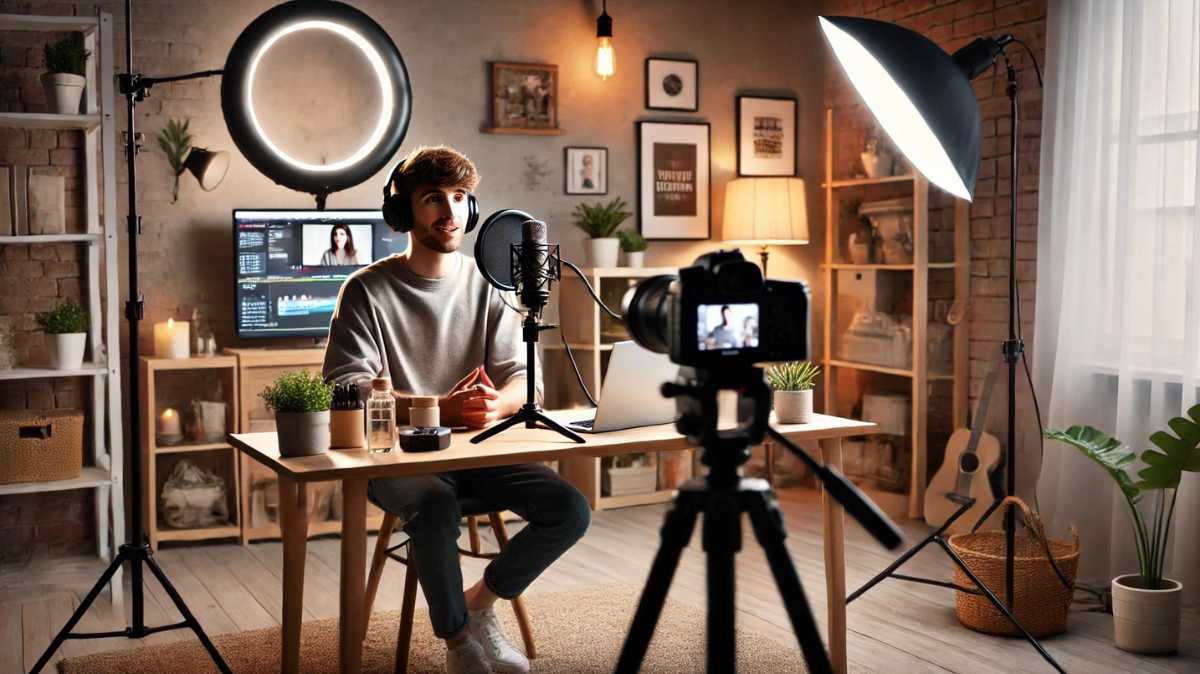Video content dominates the internet, and vlogging is one of the most popular formats. Whether you’re a seasoned vlogger or just starting out, mastering the art of filming is essential to stand out from the crowd. In this comprehensive guide, we’ll dive deep into the best vlog filming tips, providing practical insights, expert advice, and actionable steps to improve your video quality and engagement.
1. Understanding Your Niche
Before diving into the technicalities of filming, the first step in vlog creation is to understand your niche. Knowing your target audience and the type of content they prefer can make all the difference. Are you creating travel vlogs, beauty tutorials, or tech reviews? Each niche comes with unique filming challenges and viewer expectations.
- Choosing Your Vlog Style: Identify whether your vlogs will be narrative-driven, casual updates, or tutorials. This will shape how you approach filming, pacing, and editing.
- Identifying Your Audience: Research who your audience is—age, interests, and demographics. Tailor your content to engage them specifically.
Example: A beauty vlogger might focus on close-ups and product shots, while a travel vlogger may prioritize wide-angle scenic views.
2. Pre-Production Planning
A successful vlog starts long before you hit the record button. Proper pre-production planning is essential to ensure your filming process is smooth and efficient.
- Scripting: While not every vlog requires a script, having a general outline or talking points helps keep your content focused and avoids rambling.
- Storyboarding & Shot List: For more complex vlogs, creating a storyboard or shot list helps visualize the flow of your video and ensures you don’t miss important scenes.
- Organizing Equipment: Make sure all your equipment—cameras, tripods, microphones, and lights—are ready and functioning.
Pro Tip: Organize your shoot into specific blocks of time, accounting for setup, filming, and breakdown. This ensures you remain efficient and productive during the filming process.
3. Essential Equipment for Vlogging
To produce high-quality content, investing in the right equipment is key. However, you don’t need to break the bank to get started. Here’s what you’ll need:
- Best Cameras for Vlogging: Cameras like the Sony ZV-1 or the Canon EOS M50 are great options for vloggers. They offer excellent video quality, flip-out screens, and easy-to-use interfaces.
- Tripods: A steady shot is crucial for professional-looking vlogs. Portable tripods such as the Joby GorillaPod allow for versatile filming angles.
- Microphones: Poor audio quality can ruin even the best visuals. A reliable external microphone like the Rode VideoMic can make a huge difference.
- Lighting Gear: Natural lighting is great, but when shooting indoors or at night, equipment like ring lights or softbox lights are necessary.
For budget-conscious vloggers, even a smartphone with a good camera and external clip-on microphone can work wonders.
For more gear recommendations, check out Techradar’s Best Vlogging Cameras Guide.
4. Camera Settings & Angles
Even with the best camera, using improper settings can result in subpar footage. Here are the essential camera settings to master:
- Frame Rate: Typically, 24fps is ideal for a cinematic look, while 30fps offers a smoother video feel. For slow-motion shots, you might want to use 60fps or higher.
- Resolution: Aim to film in at least 1080p HD, though 4K is becoming the standard for high-quality vlogs.
- Angles: Experiment with different camera angles. The rule of thirds is a classic technique to frame your subject interestingly.
- Close-ups vs. Wide Shots: Close-ups draw attention to details, while wide shots are great for setting the scene.
5. Lighting Tips for Perfect Vlogs
Lighting can make or break your vlog. Properly lit scenes convey professionalism and are more engaging for viewers.
- Natural Lighting: Use natural light whenever possible. Position yourself facing a window for soft, flattering lighting.
- Softboxes and Ring Lights: For indoor shoots, softboxes diffuse light to eliminate harsh shadows, while ring lights provide an even glow, perfect for beauty and tutorial vlogs.
- Golden Hour: When filming outdoors, aim to shoot during the “golden hour” (shortly after sunrise or before sunset), where the lighting is soft and warm.
6. Sound Quality: The Overlooked Aspect
Audio quality is just as important as video quality. If your audience can’t hear you clearly, they’ll quickly lose interest.
- External Microphones: Use an external microphone to capture clearer sound. Lavalier mics are excellent for talking-head shots, while shotgun mics are better for more dynamic settings.
- Reducing Background Noise: Always try to film in quiet environments, and consider using soundproofing gear or noise-canceling software during post-production.
- Post-Production Sound Editing: Tools like Audacity can help you clean up audio and remove unwanted noise.
To learn more about sound recording techniques, visit Shure’s Guide to Microphone Basics.
7. Background & Set Design
Your background plays a crucial role in setting the mood of your vlog.
- Clean and Professional: A cluttered background can distract viewers. Make sure your space is tidy and visually appealing.
- Props and Decor: Use props sparingly to enhance the theme of your vlog. A plant or a well-placed book can make the frame more interesting without overwhelming it.
- Color Scheme: Consistent colors in the background can add a professional touch. For instance, neutral tones work well for most settings.
8. Filming Techniques for Dynamic Shots
The way you film adds to the storytelling. Whether it’s panning the camera to reveal a new scene or zooming in for emphasis, here are some techniques to elevate your vlog:
- Panning and Zooming: Use these sparingly, as too much movement can disorient viewers. Slow, smooth pans or zooms are ideal for highlighting specific points or showing context.
- Framing and Composition: Follow basic composition rules, like the rule of thirds, to keep your shots visually balanced.
- Cinematic Shots: For those who want to add a cinematic flair, consider using slow-motion shots, time-lapses, or shallow depth-of-field effects.
9. Editing for Engagement
Filming is only half the battle; the real magic happens in the editing room. Here’s how to make your vlog pop:
- Cutting Unnecessary Footage: Keep your video concise and to the point. Long-winded clips can cause viewers to lose interest.
- Adding Transitions: Smooth transitions between scenes help maintain the flow of your video.
- Incorporating Music: Use royalty-free music to enhance the emotional tone of your video.
- Color Grading: Adjust the color balance in your video to create a consistent and polished look.
Pro Tip: Use software like Adobe Premiere Pro or Final Cut Pro for advanced editing features.
10. Optimizing Your Vlog for SEO
To ensure your vlog reaches as many viewers as possible, it needs to be SEO-friendly. Here’s how:
- Use Keywords: Include relevant keywords in your video title, description, and tags. For instance, “vlog filming tips” should be present in the title and sprinkled throughout your content.
- Eye-Catching Thumbnails: Your thumbnail is the first thing people see. Make sure it’s bright, clear, and clickable.
- Closed Captions: Adding captions not only helps with accessibility but also boosts SEO as search engines can crawl the text.
For more SEO insights, visit Moz’s Guide to Video SEO.
11. Incorporating Storytelling
Good vlogs tell stories, not just capture random footage. Even if you’re filming a product review or tutorial, structuring your vlog like a story will keep viewers hooked.
- Engaging Opening: Start with a hook to grab attention right away.
- Conflict and Resolution: Create a narrative arc where you present a challenge and then solve it.
- Emotionally Resonant Stories: Sharing personal stories or experiences can help your audience connect with you on a deeper level.
12. Filming On-the-Go
Travel vlogs or outdoor content requires a different set of skills and equipment.
- Portable Gear: Opt for lightweight and portable equipment such as the DJI Osmo Pocket for stabilized shots on the move.
- Stabilizing Shots: Use gimbals or action cameras with built-in stabilization for smooth footage even when you’re walking or moving quickly.
13. Consistency & Frequency
Staying consistent is critical to growing your vlog. Viewers appreciate reliability.
- Posting Schedule: Stick to a consistent posting schedule, whether it’s once a week or bi-weekly. This helps build anticipation.
- Batch Filming: Filming multiple vlogs in one session can save you time and keep you ahead of schedule.
- Managing Burnout: Avoid burnout by taking breaks and pacing yourself.
14. Legal Considerations for Vloggers
When creating content, make sure you’re on the right side of the law.
- Copyright Laws: Always use royalty-free music or obtain licenses for any songs you include.
- Public Filming: Be mindful of filming in public spaces where privacy laws may apply.
15. Analyzing & Improving Your Vlogs
Once your vlogs are live, take the time to analyze their performance.
- Review Analytics: Platforms like YouTube offer detailed analytics on watch time, engagement, and viewer demographics.
- Audience Feedback: Encourage viewers to leave comments, and use their feedback to improve future vlogs.
External Link: For more tips on growing your channel, check out YouTube’s Creator Academy.
FAQs
1. What camera settings should I use for vlogging?
Most vloggers use 24fps for a cinematic look, 30fps for general vlogging, and 60fps or higher for slow-motion footage.
2. How can I improve audio quality in my vlogs?
Invest in a good external microphone, like the Rode VideoMic, and record in quiet environments to reduce background noise.
3. What type of lighting is best for vlogging?
Natural lighting is ideal, but when filming indoors, softbox lights or ring lights are excellent for creating a soft, even glow.
4. How do I keep my audience engaged?
Focus on storytelling, keep your content concise, and use dynamic shots and editing techniques to maintain viewer interest.
5. Can I vlog with just my phone?
Yes, many successful vloggers started with smartphones. Just make sure to invest in a good external microphone and possibly a portable tripod.
6. How often should I post vlogs?
It depends on your audience and schedule, but consistency is key. Most vloggers post once a week or bi-weekly.
Conclusion
Creating a successful vlog requires a blend of technical skill, creativity, and consistency. By following these vlog filming tips, you’ll be well on your way to producing professional, engaging content that resonates with your audience. Keep learning, stay authentic, and most importantly, have fun with the process!
Author

An aspiring business leader, I am working towards my dream of graduating from Stanford University with a degree in Business Management. Passionate about sharing knowledge, I strive to empower others through education and collaborative learning.
View all posts


